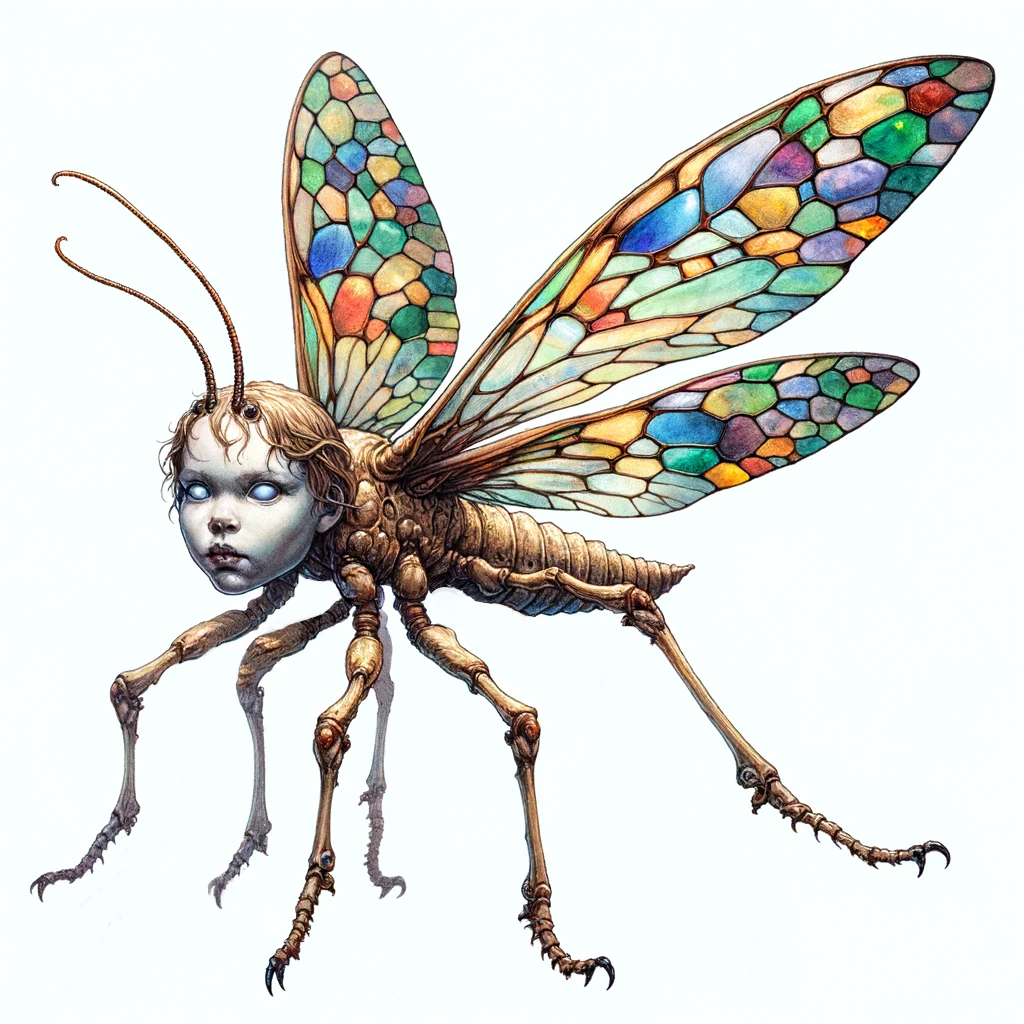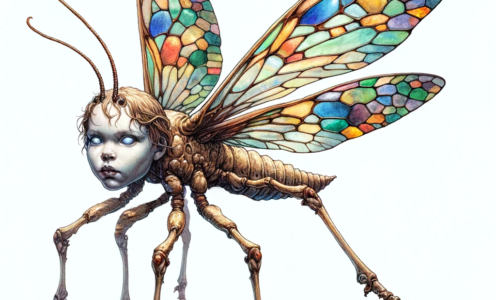Doom Locust
| CLIMATE/TERRAIN: | Any |
| FREQUENCY: | Very Rare (Rare on Lower Planes) |
| ORGANISATION: | Swarm |
| ACTIVITY CYCLE: | Any |
| DIET: | Omnivorous |
| INTELLIGENCE: | Very (11) |
| TREASURE: | Nil |
| ALIGNMENT: | Neutral |
| NO. APPEARING: | 1d10 x 200 |
| ARMOUR CLASS: | 4 |
| MOVEMENT: | 6, Fly 18 |
| HIT DICE: | 1 |
| THAC0: | 16 |
| NO. OF ATTACKS: | 2 |
| DAMAGE/ATTACK: | 1d4+2 / 1d2 |
| SPECIAL ATTACKS: | Swarm attack |
| SPECIAL DEFENCES: | Blind, charm |
| MAGIC RESISTANCE: | 90% (25% vs. fire magics) |
| SIZE: | T (approx. 1′) |
| MORALE: | Champion (15) |
| XP VALUE: | Variable |

Doom locusts, also called hungerchildren, are harbingers of doom and destruction that appear throughout the planes. They have the form of large locusts with the features of small children and wings of stained glass.
Their heads are those of infants with compound eyes and powerful mandibles. They have six legs, two of which are the withered arms of young children, and the remainder being thorny insectile legs. Individually, the call of a doom locusts sounds very much like the weeping of children, but collectively, these cries unite as a great voice chanting ‘Doom, doom.’ These creatures descend in great swarms upon places that are doomed. The destruction that follows is not caused by the doom locusts, but by an outside source, be it famine, volcano, Battle War battle or other form of destruction. The doom locusts are not the cause of doom, but rather, the symptom.
COMBAT: Doom locusts always travel in swarms, and never attack singly (typically 5-10 locusts at a time). Rather, they attack in groups, literally covering a person and biting them to death. Additionally, when doom locusts are close enough to a person to bite, they inflict an additional 1d2 points of damage by clawing and scratching their victims. Four times per day, the entire swarm may descend upon and attack a single creature. Surrounded by a screaming whirlwind of locust-things, the focus of the attack must make a saving throw vs. wands or be stripped to the bone by the ravenous host.
Should the roll succeed, the target breaks free of the swarm suffering 4d6+2 damage from the feeding swarm. Also note that because the doom locusts can bite through metal and stone, they treat all Armour Classes are two levels lower than normal.
The wings of doom locusts are highly reflective, resembling sections of stained glass. In bright conditions, lights shining off their wings has a 25% chance to blind a random opponent every other round. In addition to this form of defence, the hungerchildren have a more unusual defence—a highly specialised charm ability. Should any female attempt to harm a doom locust, she is affected as by a charm personspell. Those affected will believe that the doom locust has the face of her child, regardless of whether she actually has any children. There after, she will refuse to allow harm to come to the hungerchildren.
Doom locusts are vulnerable to fire magics. In addition, individual locusts can be turned as though they were mummies. However, the swarm can not be driven away unless the doom they presage is averted. If the coming doom is not averted, by the doom locust swarm is destroyed, at midnight of the night the last doom locust is destroyed, the entire swarm will resurrect and continue to plague the region.
HABITAT/SOCIETY: The doom locusts are harbingers of doom that plague every plane. Doom locusts descend upon places where significant destruction will occur. Some places, especially in the Lower and Chaotic Planes, face destruction by their very nature. The destruction of such places is rarely significant enough to attract the doom locusts.
When the doom locusts descend upon a place, they come approximately one week prior to the doom that is to befall. Once there, they settle in the out-skirts of the region and for a single day do nothing but cry their mournful song. As the last doom locust stills its voice, the graves of children open throughout the area, releasing a new host of doom locusts.
Then, the doubled host of locust-things proceed to feast upon the doomed site, devouring plants, dirt, animals, wood, stone, even metal and people.
Oddly, the damage is rarely as bad as that of a natural locust plague. The night prior to the devastation, the locusts fly into the darkness. With the new day, the area is destroyed but the prophesied doom.
ECOLOGY: The doom locusts are unnatural creatures, even by the standards of the planes, giving nothing to the land, bringing destruction in their wake. When doom locusts are slain, they burst into flame and melt into puddles of black and toxic sludge. Many scholars claim that doom locusts are a unique type of undead.
Doom locusts have been reported as long as any remember. They have appeared at key moments when religions were shattered, empires destroyed, sites slid into the Lower Planes and, once came to Sigil, just prior to a monumental exhibition of the Lady of Pain’s wrath. The doom locusts are found more often in the Lower Planes, due to the sheer quantity of violence found in those planes. Recently, doom locusts have been reported in the upper reaches of Arcadia and in Regulus on Mechanus.
Source: Chris Nichols. Author’s Note: The doom locusts are derived from Apocalypse by Nancy Springer and from the Revelation of St. John of Patmos. Largely, the doom locusts are a plot device to herald a major event in a campaign.


